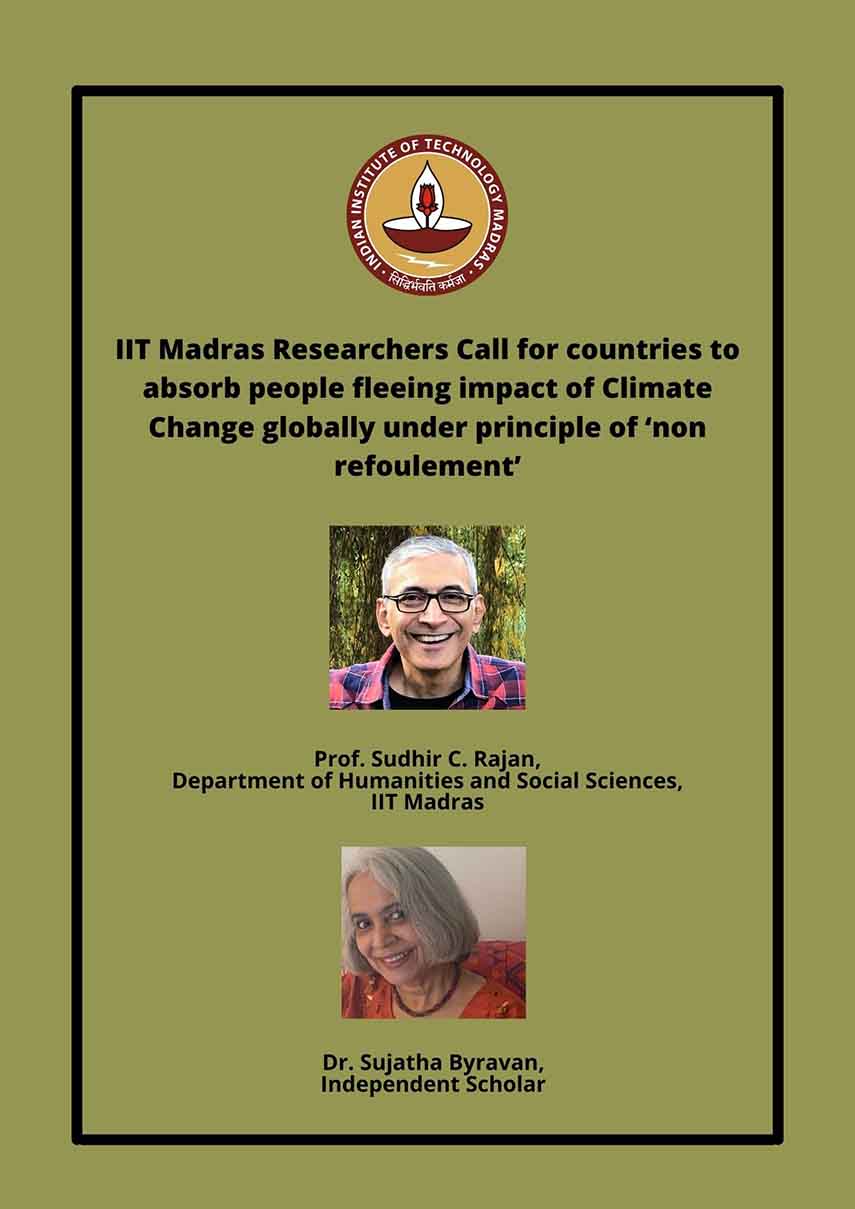Indian Institute of Technology Madras researchers along with an independent research scholar have urged countries to absorb "climate migrants and climate exiles" in proportion to their green house emission. They suggest a normative framework to address cross-border migration due to climate change.
This research has come as a befitting humane gesture and a new hope from IIT Madras ahead of World Environment Day for helpless 40 million people, who are reported to have migrated from their homelands in 2020, mostly due to climate change.
Researchers say that climate change is intensifying the push for people to migrate. They have suggested that all asylum seekers have to be absorbed into host countries under the principle of 'non refoulment'.
This will ensure that refugees are not forced to return to their home countries to face harm.
Also, asylum seekers from vulnerable zones must be absorbed in host countries in proportion to their greenhouse gas emissions.
The researchers conclude that given the severity of the anticipated Global Environmental Changes and associated harms, taking early and appropriate action is vital.
However, the question ‘did this person migrate because of climate change?’ may never be fully answered, researchers found.
This issue was taken up by Prof. Sudhir C. Rajan, Department of Humanities and Social Sciences, IIT Madras and Dr. Sujatha Byravan, an Independent Scholar.
They have published a Research paper titled ‘Cross border migration on a warming planet: A policy framework.’
They propose a normative framework with responses to address cross-border migration. The Paper was published in the reputed peer-reviewed journal WIRES Climate Change.
Speaking about the need for such research, Prof. Sudhir C Rajan said, “In recent years, the increased risks of environmental hazards including climate change, have intensified the push to migrate”.
One such case is the teeming slums of Bangladesh’s capital Dhaka, where the residents are on the frontlines of a climate crisis.
People living along the coast have been migrating to the Bangladeshi capital due to monsoon flooding and cyclones caused by rising sea levels. “For these residents, the worsening climate change is not a faraway threat. It is a grim reality”, he said.
Prof. Sudhir C. Rajan further said, “Climate scientists have known for more than a decade that tens of millions of people, if not more, will be forcibly displaced from some of the poorest countries as a result of climate change”.
“If their countries are no longer viable homes through no fault of their own, the international community has a moral responsibility to provide refuge”, he added.
Dr. Sujatha Byravan, Co-Author of this Research said, “There is an urgent need to ensure that people from countries that have emitted very little greenhouse gases are not left fending for themselves”.
“Climate exiles or migrants have no legal standing. These are the kinds of issues that ought to be addressed in the climate negotiations track of Loss and Damage under non-economic losses.”
Migration Results from multiple factors
The study points out that the Internal Displacement Monitoring Centre reports that 40.5 million people were newly displaced in 2020. “30 million among these were forcibly displaced due to weather-related disasters”.
Usually, migration is a result of compound factors. The multiple interconnections among the drivers of migration makes it difficult to identify GEC as the only or proximate cause of migration.
The major drivers of migration are a combination of on-going Global Environmental Changes (GECs) as they interact with social, economic and political conditions.
Hence, the researchers have identified a normative framework. This highlights that the prevailing international law is barely adequate to protect the entire class of forcibly displaced people.
Refugee vs asylum seekers vs environmental migrant
The researchers have defined refugees and asylum seeker. Refugee is a person who is outside his or her country of nationality or habitual residence.
He/she has a well-founded fear of being persecuted because of his or her race, religion, among others; and is unable to avail him or herself of the protection of that country or to return there, for fear of persecution”.
Asylum seeker is a person outside their country of origin who has sought protection under the Convention but still is awaiting the outcome of their claim to refugee status.
Climate or Environmental Migrant is a person who, predominantly for reasons of climate or other environmental change, is forced to leave their home.
In the study, researchers use the term ‘climate exiles’ to designate those cross-border environmental migrants for whom the push for migration is mainly because of climate change.
There is absence of a coherent institutional and legal framework at international and national level to protect the rights of climate exiles. This creates an urgent need to work on international law to protect climate exiles.
A sensible response for climate exiles.
It is difficult, if not impossible in most cases, to identify a specific climate-related event as being responsible for migration.
Waiting for clarity and classifying people based on whether they migrate because of climate change may moreover worsen the scenario.
Hence, the researchers suggest ‘strong’ and a ‘mild’ versions of the case for remedial justice to climate migrants.
Strong Approach
It says all asylum seekers must be deemed worthy of refuge, even if they do not meet the narrower requirements of the Refugee Convention.
Parties who want to protect climate exiles must honour all identifiable asylum seekers under a non-refoulement principle.
The host countries may choose to formulate a protocol for developing shares that are proportionate to their cumulative emissions.
Mild Approach
It emphasizes on identifying vulnerable zones based on scientific evidence. Low-lying states, countries with low lying delta regions, areas facing desertification or flooding, hill-slopes subject to erosion, are all vulnerable zones.
The researchers say that asylum seekers from vulnerable zones must be given rights to free movement and absorbed in host countries, in proportion to their greenhouse gas emissions or through a similar fair agreement.





